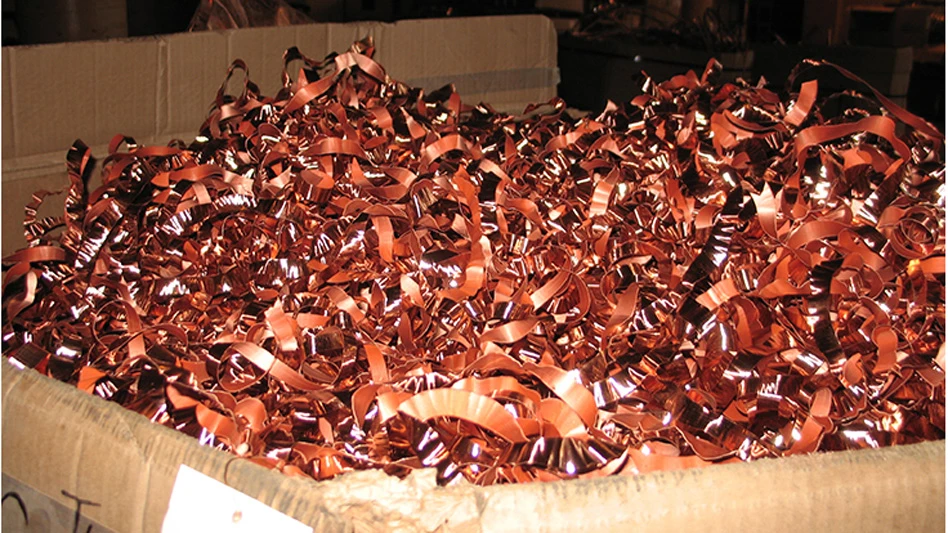The improving U.S. economy may be generating optimism, but a snapshot of nonferrous scrap markets in early 2015 shows nothing but tough news. Many scrap dealers say they expect to see difficult markets through the first quarter of this year at least.
However, aluminum scrap dealers are expressing optimism in the mid- to long-term. A key reason: strong interest from the automotive sector. While this is positive news, it has yet to be reflected in price or demand.
A representative from a large aluminum scrap processor says his company is having a difficult time finding markets for most of its material. “Consumers have been very conservative with the normal grades,” he says. As a result, little of this material has entered the market. Also, the closed-loop approach used by some automakers prevents some scrap dealers from accessing the aluminum scrap generated at auto plants.
Despite his pessimistic short-term outlook, one scrap dealer says he is more bullish on aluminum markets later in 2015. After challenges with oversupply during the winter months, he says he expects to see supply deficits crop up by the third and fourth quarter of the year, with those deficits extending out for several years. “I expect to see more demand for every grade of aluminum going forward. All statistics point to a deficit over the next few years,” he says.
A dealer based in the Midwest says aluminum scrap consumers are having a difficult time selling their finished products, and some scrap dealers are holding onto inventory until margins improve.
The aluminum consulting group Harbor Intelligence, Austin, Texas, also reports that “market sentiment has been deteriorating.”
Analysis by Harbor Intelligence published in the Aluminum Association’s “Aluminum Highlights” report also notes that “no spot activity of over 100 metric tons between consumers and suppliers has been confirmed since the first half of December.” In fact, the report continues, “no relevant buyer (of aluminum) has been active at all in the spot market so far this year.”
Copper markets are in worse shape than aluminum markets. Prices in late January are at or near five-and-a-half year lows. One source says that as of late January, copper was selling for roughly $2.57 per pound on the March COMEX compared with copper’s September 2014 COMEX price of approximately $3.02 a pound.
A major big factor in copper’s slump has been the softening Chinese economy. The World Bank forecasts China’s economic growth to continue to cool, declining from 7.4 percent in 2014 to 7.1 percent in 2015. Looking out further, the World Bank says it expects the Chinese economy to slow down even further through 2017.
With Chinese New Year in February, it is unlikely there will be much of an uptick in demand from Chinese consumers until perhaps March.
Sponsored Content
Still relying on manual sorters?
Let AI do the heavy lifting. Waste Robotics delivers reliable, high-performance robots tailored for complex waste streams. They require minimal maintenance, are easy to operate, and are designed to boost your recovery rates. Smarter sorting starts with the right partner. Waste Expo Booth #1969 & REMA #2843
Click here to see our robots in action!Sponsored Content
Still relying on manual sorters?
Let AI do the heavy lifting. Waste Robotics delivers reliable, high-performance robots tailored for complex waste streams. They require minimal maintenance, are easy to operate, and are designed to boost your recovery rates. Smarter sorting starts with the right partner. Waste Expo Booth #1969 & REMA #2843
Click here to see our robots in action!Additionally, the World Bank has downgraded its global growth forecast for 2015 from 3.4 percent to 3 percent.
The net result of the slowdown in copper demand from China is reflected in the shift in the balance between supply and demand. The International Copper Study Group, Lisbon, Portugal, says that after five straight years of deficits, copper likely will show a production surplus of 390,000 tons this year.
Get curated news on YOUR industry.
Enter your email to receive our newsletters.

Explore the February 2015 Issue
Check out more from this issue and find your next story to read.
Latest from Recycling Today
- Nexwaste acquires 3 Texas businesses
- Maryland EPR bill awaits signature
- ABTC sells Fernley, Nevada, property
- Aqua Metals developing LFP recycling process
- RMR ceases shredding operations in Newport, Kentucky
- Bluewater streamlines solar panel replacement, recycling in Bermuda
- Steve Levetan to receive ReMA Lifetime Achievement Award
- ReMA, Germany’s VDM issue joint tariff statement








